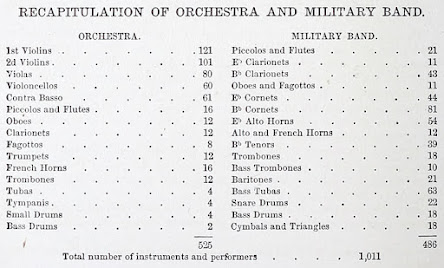Friday, December 30, 2022
The first Sousaphonist in full color!
I recently discovered that Ancestry.com now has a photo colorizing feature, and I had to try it out on Conrad. He's looking pretty sharp in 1898 above, with Conn's first Sousaphone. And here is his portrait with Sousa's Band a few years earlier:
Friday, October 7, 2022
Hall of Shame Sousaphone Sightings
While at a leadership development conference in Atlanta this week, we had some time to kill before our flight home, so we checked out the College Football Hall of Fame. It was a pretty cool place, featuring not only a lot of USC stuff (see below), but also some Sousaphones that brought a wry smile to my face!
In the small marching band exhibit, there were only two instruments displayed in the case - a trombone, held by a mannequin sporting a Morehouse College band uniform, and an Ohio State University Sousaphone, seen above, alongside a portion of a video montage showing a Stanford tuba player (I think).
Now, to be fair, I was thrilled at the representation of this glorious instrument, but I also loved seeing how they got the Buckeye horn completely wrong! Here's a close up:
Saturday, July 30, 2022
P. S. Gilmore and 67 tubas (!) in 1869
My family visited Boston for the first time this summer, and that encouraged me to poke around to see what I could learn about the National Peace Jubilee, held in Boston on June 15-19, 1869. This massive event was conceived and led by the great bandmaster P. S. Gilmore, who, two years later, wrote a massive history of it (758 pages!). Here's the cover page (the entire book is available online courtesy of the HathiTrust):
I am familiar with every step of [the Jubilee's] progress, from its inception to its consummation; but can I write it out so as to make it interesting to the general reader? that is the question. Well, I can try! The result of the trial - and a very severe trial it has been! - is this volume, which the author gives to the public with great reluctance, feeling it is not in many respects what is expected, nor what it ought to be. Still he hopes its shortcomings may be overlooked, it being his first, and in all probability his last, effort in the field of literature.He then concluded the introduction by saying, "critics and reviewers are respectfully requested not to put too fine a point upon their pencils, remembering that 'Blessed are the merciful, for they shall obtain mercy' [a quote from the Bible - Matthew 5:7]."
Tuesday, July 19, 2022
P. S. Gilmore and that Monster Tuba
- The giant tuba was built by Besson for the Exposition Universelle of 1889 in Paris.
- Carl Fischer of New York, who was the sole agent in America for Besson instruments, visited the horn in Paris, and decided to purchase it and have it shipped home once the Exposition closed in November.
- That very month, Fischer wrote about the monster bass in his journal The Metronome, calling it "A novel instrument commended to P. S. Gilmore's attention."
- Then, in 1891 or 1892, a lithograph was made that shows the instrument in the back row of "Gilmore's One Hundred: The Greatest Band in the World" (shown at the top of this post).
- But I found no record of the beast appearing at a concert of Gilmore's Band. There are a few surviving photos and lithographs of the band on tour in 1892, but the giant tuba is not shown in any of them. Nor was it mentioned in connection with Gilmore anywhere in the press that I could find. And there was no record of it making an appearance at the World's Columbian Exposition in Chicago in 1893, which was mentioned as a possibility in The Metronome in early 1890.
- But, again, it was featured prominently in that lithograph from 1891 or 1892, as you can see:
Monster Tuba Paris Exhibitions: You surprise us when you say "Gilmer" would buy that instrument Don't you remember we told you it was not made to play only for a trophy or show sign It can be blown but not used in an Orchestra The tubings are too narrow it is not properly a double BBb Monster but a medium between Eb & Bb double Monster If you want one for Chicago we had better make another then with all tubings in right proportion and properly tuned but do you think one would be able to get a player that would be able to give out a sufficient amount of wind to play the instrument. If Gilmer wants to buy the above sell it to him by all means and have another for Chicago which taken in proper time we could do it with care and turn out a proper article in fact without hearing further from you we shall put one in hand soon shall we make it in the new pitch We are only afraid Gilmour would afterwards find the above most satisfactory and this would perhaps make a difference between you and him.
- Gilmore was apparently interested in buying the giant tuba from Fischer at that time, although we still don't know exactly why - except that, based on what Besson goes on to say, it was probably to be played in his band at some point (perhaps in Chicago?). This suggests that the lithograph was made in late 1891 or early 1892, since this letter is dated January 30, 1892.
- But Besson reminded Fischer that the monster was not designed to be played in an ensemble - it was only built for show, even though it is fully functional (which I know, since I've played it myself!). That probably explains why there is no record of it being played in Gilmore's Band. It obviously made an appearance for the photo shoot that led to the lithograph, but I can only imagine that when it was played within earshot of Gilmore, it got a big thumbs down and the sale was off!
- Besson suggests that they could build a replica for the World's Fair in Chicago that could be played in an ensemble, if that's what Fischer desired, but that doesn't seem to have happened - even though he said that they could (or should?) start working on it right away. Fischer apparently called that off.
- The last sentence is the most curious, and I'm not sure just how to read it. In what sense would a replica monster tuba "perhaps make a difference between you and him," meaning Fischer and Gilmore? Was their relationship strained for some reason? Or did Besson just mean that a replica giant tuba that plays in tune would satisfy Gilmore's high standards of musical excellence? I'm guessing it's the latter.
Wednesday, July 13, 2022
Monday, July 4, 2022
A Special Visit to the Harvard Tuba
When my family decided to vacation up at Acadia National Park this past week, we tacked on a brief visit to Boston, since we had never been to that great city before, and it was basically on the way to Maine. For me, that meant dropping in on the Harvard Tuba in its native environment!
Through the gracious hospitality of Michael Ruderman (shown with me above), we were not only given access to see this monstrous beast, which had been the subject of my research and writing a few years ago (click here for all of that), but Michael also gave us an insider's tour of the heart of Harvard University, which was fascinating (for example, I now know the truth about the iconic John Harvard statue!).
But for me, the highlight of the tour was the band room. I knew that's where the Harvard Tuba had lived for years, precariously propped up in a corner, but it was great to actually see that hallowed, albeit disheveled, ground.
Here's the building that is the home for the Harvard University Band, as well as other organizations:
And here's the front door, with Michael letting us in:
Once inside, we connected with current band director Mark Olson, who was also very gracious in facilitating our visit. Here he is unlocking the door to the actual Harvard Band Room, which is slightly below ground level, where you can see their oversized bass drum, known as "Bertha":
Saturday, April 23, 2022
Rescuing a 1925 Pan American 64-K
One of my favorite tuba-related stories is very personal, and goes back eleven years. I was surprised to discover that I hadn't blogged about it before, but then it dawned on me: this was before I stumbled upon the hobby of researching the history of the Sousaphone!
So, finally, here's the story . . .
As a seventh grader, in late November 2011, my son, Jonathan, expressed interest in seeing what it was like to play a Sousaphone. He mentioned that he saw some old Sousaphone pieces high up on a shelf in the instrument storage room at his middle school, where he was playing tuba in the band. So he approached his director about this, and she responded that those instruments hadn't been touched for at least the 23 years she had been there.
Here's that storage room:
His director then surprised him by saying that if he could find anything among those dusty and long-neglected Sousaphone parts that worked, he could keep them, as they had no future there!
Ours had the "silver gold bell finish," costing $250 in 1928 (perhaps a bit less in 1925), although the finish was heavily worn and tarnished, as you can see from the image at the top of this post.
We then inquired with the renowned "Tuba Whisperer" at Dillon Music, Matt Walters, about what could be done to get the instrument into playable shape.
I've made the repairs, and you've got a great sounding horn! In fact, I usually play a horn I've just worked on for no more than 30 seconds, to make sure everything is working and sounding good. But I played yours for about 5 minutes, because it really sounded great! Oh, and one of the guys at the shop here has offered to buy it from you for $500, as he is looking for a decent Sousaphone.


























%202.jpeg)
%202.jpeg)

%202.jpeg)







.JPG)

.JPG)
%202.jpg)
%202.jpg)

%202.JPG)






.JPG)
